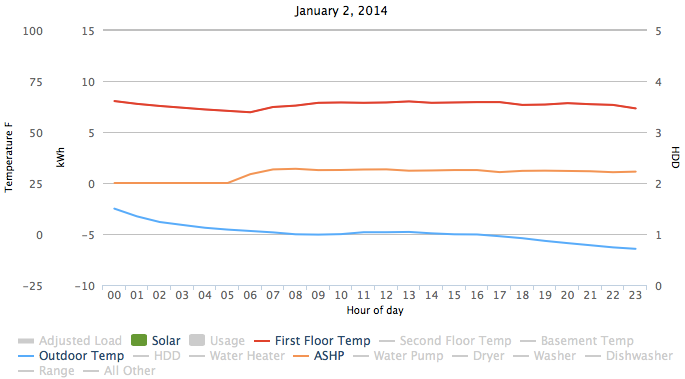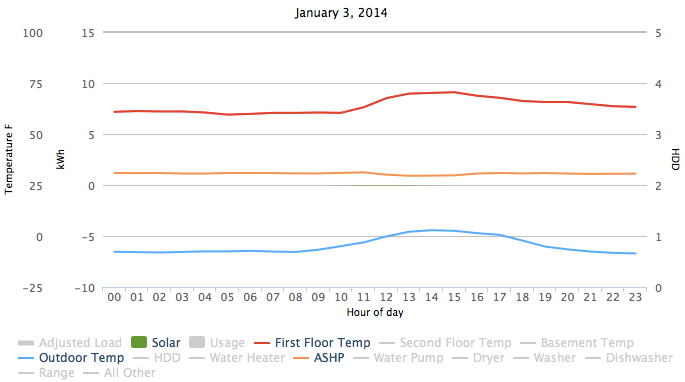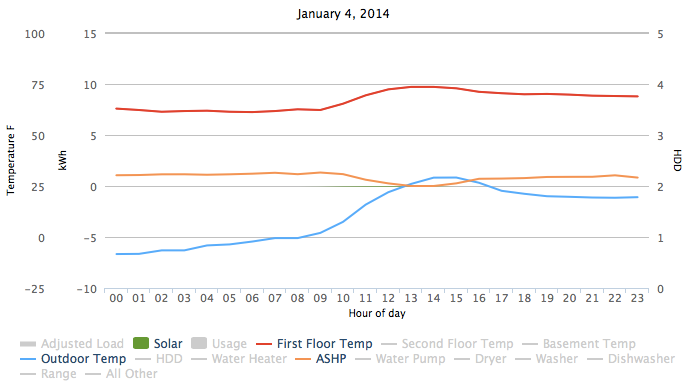January performance snapshot
Living in a super-insulated house, I get very excited when extreme cold weather arrives. It is the only way to see how well the house performs in low temperatures. This January was the coldest month that we’ve lived in the house.
We recorded 1380 HDD for January, 16% colder than January 2013. Our coldest day was January 3rd, with 69.7 HDD. Temperatures on this day ranged from a high of 2.8°F to a low of -8.5°F. Indoor temps ranged from 60°F at night to 70.5°F during the day.
I was particularly interested in how our air-source heat pump (ASHP) would perform in these long stretches of cold weather. Our unit (Mitsubishi MSZ/MUZ-FE18NA) is rated to keep producing heat down to -15°F. According to the specifications, the unit can produce 10,300 btu/hr at 5°F.
In order to determine how well the house performed thru the month I decided to keep the backup heat (electric resistance) off. This meant we relied only on our ASHP and the sun to heat the house for the month.
Looking at the data for January, it looks like our heat pump starts to fall behind demand when temperatures slip below zero. This appears to happen mainly at night. During the day, a small amount of sunlight can raise indoor temps even in the extreme cold. January 1-3 offer a good example.
I normally turn the heat down at night or off. I did this the night of January 1st. Night temps were not particularly cold, but continued to drop throughout the next day. By 7am Jan 2nd, the inside temp got down to 60°F and the outside temp had reached zero. By the time I turned on the heat again in the morning, the ASHP was not able to make up the difference for most of the day. A little sun helped get the inside temp up to a high of 64°F. On Jan 3rd, I considered turning on the backup heat, but I held out because the forecast said clear skies. By the afternoon inside temps were back up to 70 while outside temps hovered around 2°F. By Jan 4th, outdoor temps were well over the zero mark.
The January 2nd experience and a fortuitous conversation with Mike Duclos that day, convinced me to leave the thermostat set to 68°F when temperatures are forecast to be in single to negative digits overnight. This makes it easier for the ASHP to keep up with the demand and lowers the temperature differential it has to make up.
In total, our ASHP used 529 kWh in January. If we paid for electricity, our heat would have cost us just under $80.



Check out the interactive version of these charts on my other site, Netplusdesign.

Categories
- Air sealing 13
- Appliances & Fixtures 4
- Art 3
- Award 4
- Bathroom 8
- Batteries 1
- Decor 5
- Design 10
- Electrical 5
- Energy Calculations 13
- Energy Monitors 4
- Farm 1
- Finance 1
- Flooring 3
- Foundation 9
- Framing 8
- Heating 9
- House 7
- Insulation 8
- Kitchen 6
- Landscaping 3
- Lessons Learned 1
- Performance 60
- Plumbing 10
- Porch 5
- Radon 1
- Rainwater catchment 3
- Research / study 1
- Roof 7
- Septic / Waste water 2
- Sheetrock 6
- Siding 9
- Site Work 22
- Smart home 1
- Solar 64
- Solar Obsessed 10
- Stairs 2
- Surveying 3
- Ventilation 8
- Weather 1
- Windows & Doors 14
- plug-in 3
Archive
- Jan 2021 1
- Dec 2020 2
- May 2020 1
- Jan 2020 1
- May 2019 1
- Jan 2019 3
- Sep 2018 2
- Aug 2018 2
- Jan 2018 1
- Oct 2017 2
- Apr 2017 1
- Jan 2017 1
- Oct 2016 2
- Aug 2016 1
- Apr 2016 2
- Jan 2016 2
- Nov 2015 2
- Oct 2015 1
- Jul 2015 1
- May 2015 1
- Apr 2015 1
- Jan 2015 1
- Dec 2014 1
- Nov 2014 2
- Oct 2014 4
- Sep 2014 2
- Aug 2014 1
- Jul 2014 1
- Mar 2014 3
- Feb 2014 2
- Jan 2014 2
- Nov 2013 1
- Oct 2013 1
- Sep 2013 1
- Jul 2013 3
- Apr 2013 3
- Jan 2013 3
- Dec 2012 2
- Nov 2012 3
- Oct 2012 1
- Sep 2012 3
- Aug 2012 3
- Jul 2012 2
- Jun 2012 1
- May 2012 3
- Apr 2012 2
- Mar 2012 4
- Feb 2012 4
- Jan 2012 5
- Dec 2011 4
- Nov 2011 9
- Oct 2011 10
- Sep 2011 9
- Aug 2011 6
- Jul 2011 6
- Jun 2011 12
- May 2011 8
- Apr 2011 4
- Mar 2011 5
- Jan 2011 6
- Dec 2010 9
- Nov 2010 3
- Oct 2010 4
- Sep 2010 6
- Aug 2010 8
- Jul 2010 6
- Jun 2010 3
- May 2010 3
- Apr 2010 1
- Mar 2010 3
- Feb 2010 3
- Dec 2009 1
- Jun 2009 1
- May 2009 1
- Feb 2009 1
- Dec 2008 1
- Nov 2008 1
- Jun 2008 1
